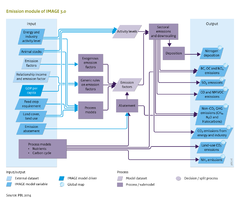Emissions/Description: Difference between revisions
Jump to navigation
Jump to search
No edit summary |
m (Text replace - "Livestock" to "Livestock systems") |
||
| Line 46: | Line 46: | ||
The CO2 exchange between terrestrial ecosystems and the atmosphere computed by the LPJ model is described in [[Natural vegetation and carbon cycle]]. The land-use emissions model focuses on emissions of other important gases, including greenhouse gases (CH4, N2O), ozone precursors (NOx, CO, VOC), acidifying compounds (SO2, NH3) and aerosols (SO2, NO3, BC, OC). | The CO2 exchange between terrestrial ecosystems and the atmosphere computed by the LPJ model is described in [[Natural vegetation and carbon cycle]]. The land-use emissions model focuses on emissions of other important gases, including greenhouse gases (CH4, N2O), ozone precursors (NOx, CO, VOC), acidifying compounds (SO2, NH3) and aerosols (SO2, NO3, BC, OC). | ||
For many sources, the emission factor approach (see formula 1.) is used (see the atmospheric emissions table [[Atmospheric_emissions_table|Table]]). For anthropogenic sources, the emission factors are from the EDGAR database, with time-dependent values for historical years. During the scenario period, most emission factors are constant, except for explicit climate abatement policies (see below). However, there are some important exceptions. Atmospheric N emissions are modeled in a detailed way (see below), and in several other cases, the emission factor depends on the assumptions described in other parts of IMAGE. For example, CH4 emissions from nondairy and dairy cattle are calculated on the basis of the energy requirement and feed type (see [[Livestock]]). High-quality feed such as concentrates from feed crops have a lower CH4 emission factor than feeds with lower protein and higher contents of components with lower digestibility. This implies that when the feed conversion ratio changes, the CH4 emission will automatically change as well. Feed conversion ratios are prescribed, or are calculated on the basis of the animal productivity. | For many sources, the emission factor approach (see formula 1.) is used (see the atmospheric emissions table [[Atmospheric_emissions_table|Table]]). For anthropogenic sources, the emission factors are from the EDGAR database, with time-dependent values for historical years. During the scenario period, most emission factors are constant, except for explicit climate abatement policies (see below). However, there are some important exceptions. Atmospheric N emissions are modeled in a detailed way (see below), and in several other cases, the emission factor depends on the assumptions described in other parts of IMAGE. For example, CH4 emissions from nondairy and dairy cattle are calculated on the basis of the energy requirement and feed type (see [[Livestock systems]]). High-quality feed such as concentrates from feed crops have a lower CH4 emission factor than feeds with lower protein and higher contents of components with lower digestibility. This implies that when the feed conversion ratio changes, the CH4 emission will automatically change as well. Feed conversion ratios are prescribed, or are calculated on the basis of the animal productivity. | ||
Constant emission factors may lead to decreasing emissions per unit of product, for example when the emission factor is specified on a per head basis. An increasing production per head may then lead to a decreasing emission per unit of product. An example is the constant CH4 emission from animal waste per animal, which leads to decreasing emissions per unit of meat or milk when the production per animal increases. | Constant emission factors may lead to decreasing emissions per unit of product, for example when the emission factor is specified on a per head basis. An increasing production per head may then lead to a decreasing emission per unit of product. An example is the constant CH4 emission from animal waste per animal, which leads to decreasing emissions per unit of meat or milk when the production per animal increases. | ||
Revision as of 19:17, 16 May 2014
Parts of Emissions/Description
| Component is implemented in: |
Components:and
|
| Projects/Applications |
| Models/Databases |
| Key publications |
| References |
|
